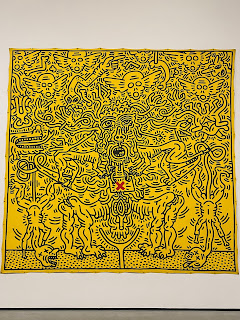The Broad Museum, Los Angeles, CA
Through October 8, 2023
Article by Cathy Breslaw
Haring’s is a story of a young man who at 20 years old moved to NYC to attend the School of Visual Arts and in the following ten years garnered worldwide recognition for his art, and then died of AIDS in 1990. Fresh out of art school, he began using white chalk to make quick temporary drawings in subway stations throughout the city. Rather than seek out the gallery and museum art world, Haring wanted his drawings to be seen by a mass audience.
So, it is ironic yet fitting that The Broad has created Haring’s first ever museum exhibition Art is For Everybody featuring over 120 artworks of drawings, paintings, sculptures, videos, installations, and archival materials. The Broad family are collectors of his work since 1982, and together with works from institutional and private collections, ephemera and documents provided by the Keith Haring Foundation, create an exhibition that is an impressive display of Haring’s work but also leads viewers to discover Haring’s personal world experience and what mattered to him during his short life.
Themes of music, politics, sexuality, war, religion, and AIDS figured prominently as his pop and graffiti-like work grew out of the influence of street culture of the 1980s. While some of his imagery is composed of simple flat figures with lines indicating breakdancing and other upbeat activities, others could be incredibly dark, with images of blood dripping out of bodies and daggers piercing through hearts including a mix of skeletons, flying saucers, daggers, nooses, nails, blood, sex acts and more abstract shapes referring to calligraphy, hieroglyphics, and primitive forms. He has a clearly defined and recognizable pictorial language using mostly black lines to delineate shapes and forms within his works. Haring wanted his work directed to the audience without the lens of a gallery, and to shine a light on broad complex subjects of his generation including protesting apartheid in South Africa, raising awareness to the crack cocaine epidemic, nuclear disarmament and AIDS.
The Broad show curated by Exhibitions Manager Sarah Loyer, spans 10 galleries. It includes representations from public art projects, public murals, subway drawings, and his love of music. In one immersive space, the backlit gallery is accompanied by a soundtrack of playlists made by the artist himself. Another gallery featured collaboration pieces by Haring and fellow artist LA II AKA Angel Ortiz as they worked together for six years during the 1980’s. Recreated in another gallery was Haring’s first major gallery show, with painted stripes in day-glo pink and orange on the gallery walls and in the center a mini Statue of Liberty. The range of Haring’s paintings also show an influence of African and Aboriginal art as well as an influence of pop-culture artists such as Andy Warhol, Roy Lichtenstein.and Jean-Michel Basquiat.
Toward the end of his life, Haring focused his work on the AIDS epidemic, painting murals for gay men’s health centers, posters and art for the activist group ACT UP. Though his career only spanned one decade, he created more than 50 public works, thousands of subway drawings, paintings, posters and murals. In one of his journal entries, Haring stated:
Art should be something that liberates your soul, provokes the imagination and encourages people to go further.
Haring’s legacy, thirty years later proves this out in his exhibition. The Broad show takes us back to the street scene and graffiti art of the 1980’s in New York City. Haring’s use of bold colors and strong cartoon-like iconic drawings together with universal themes, make his work both strongly memorable and easily accessible to all people.









